
G. De Nadai, M. Cassol, L. Lapini
Abstract
After a short philological review of the present knowledge on the otter <em>Lutra lutra</em> in Veneto Region (north-eastern Italy), the Authors refer the positive results of a first short otter survey in Venetian Alps, confirming the natural return of the otter in the Province of Belluno. These are the first sure data from Veneto Region in the XXI century, which opens new perspectives of research aimed at understanding the situation to promote the conservation of the species in north-eastern Italy.
Key words: Lutra lutra, Eurasian otter, preliminary otter survey, Belluno Province, Veneto Region, north-eastern Italy
Riassunto breve
Dopo una breve revisione filologica delle attuali conoscenze sulla lontra <em>Lutra lutra</em> nella Regione Veneto (Italia nord-orientale), gli Autori riferiscono i risultati di una prima breve otter survey condotta sulle Alpi venete, confermando che la lontra è tornata naturalmente nella Provincia di Belluno. Si tratta dei primi dati certi del XXI secolo, che aprono nuove prospettive per ulteriori ricerche finalizzate a comprendere la situazione e favorire la conservazione della specie nell’Italia nord-orientale.
Parole chiave: Lutra lutra, lontra eurasiatica, otter survey preliminare, Provincia di Belluno, Regione Veneto, Italia nord-orientale
Authors addresses:
–Gabriele De Nadai – Via Cal del Vento, 9b. I-32035 Santa Giustina Belluno, Italy gabridenadai@libero.it
–Michele Cassol – Via Fornaci 25a. I-32036 Sedico Belluno, Italy michelecassol@libero.it
–Luca Lapini – Sezione Zoologica del Museo Friulano di St. Naturale, Via C. Gradenigo Sabbadini, 22-32. I-33100 Udine Italy lucalapini1@gmail.com
Introduction
The cause of the past dramatic decline of the otter Lutra lutra all over in Western Europe is not yet fully understood, but probably was multi-factorial (Reuther & Festetics, 1980; Panzacchi et al., 2011; Hung & Law, 2016). Otter population collapse, indeed, has been due both to the high diffusion of organo-chlorinated pesticides and PCB pollutants in European trophic-chains, to habitat losses, to road kills, hunting and poaching, all independent factors which acted synergistically (Reuther & Festetics, 1980; Loy et al., 2015). The Italian status of the otter in the 50’s-70’s of the XX century mirrored the West European situation of the species, to the point that at the beginning of ‘80s only about one hundred otters survived in central-southern Italy (Macdonald & Mason, 1982, 1983; Lapini, 1985; Cassola, 1986).
In spite of a lot of questionnaire information published by Spagnesi (1980) and Pavan & Mazzoldi (1983), the extinction of Lutra lutra in Veneto Region is well documented in both specie-specific and museum papers, being apparently referred to 50’s and 70’s of the XX century (Lapini, 1985; Cassola, 1986; Rallo, 1986; De Marinis & Lapini, 1994; Meneghini et al., 2011).
The natural recovery of Lutra lutra in Italy during the XXI century, anyway, is increasingly evident both from South, North-East and North-West (Loy et al., 2015; Giovacchini et al., 2021: Fig. 1) and bodes well in the future of Italian otters, at present estimated in about 800-1000 specimens. Nevertheless, in spite of various regional camera-trapping studies (Spada et al., 2016a; Spada et al., 2016b; De Nadai et al., 2021), up to now it was never possible to verify the return of Lutra lutra in Veneto Region, despite clear data about the natural recovery of the species in the neighbouring Austria (Kranz & Poledník, 2020), Alto Adige (Righetti, 2011) and Friuli Venezia Giulia Region (Bonesi & Lapini, 2011; Iordan, 2014; Lapini et al., 2014; Pavanello et al., 2015; Lapini, 2019; Lapini et al., 2020; Giovacchini et al., 2021; Stokel et al., 2022; Lapini, 2022).
The data published by Righetti (2011) for Alto Adige/South Tyrol seem to be in good ecologic continuity with northern Veneto and one data collected by Lapini et al. (2020) is referred to the watershed between Piave and Tagliamento River-Catchments (Forni Avoltri, Udine, June, 15th, 2019: Lapini et al., 2020: 45), quite near to the regional boundary between Veneto and Friuli Venezia Giulia. The first record of XXI century on the presence of the otter in Veneto -referred to a possible sprainting site observed upstream of Sega Digon (Belluno Province) during 2019- has been communicated as a putative otter datum to various regional officers of the public Administration of Veneto Region (dr. S. Calderola) and to the Province of Belluno (dr. S. Vendrami), but it was never confirmed in the field, in spite of various attempts conducted between September and December 2020 (Stokel et al., 2022). In order to verify this putative information a preliminary bridge otter survey has been performed in the same brook-system quoted by Stokel et al. (2022) and surroundings.
Methods
The first attempts to find Eurasian otter have been conducted between October, 28th, 2022 and November, 15th, 2022 in the North-East alpine area of Belluno Province. A preliminary otter survey was carried out searching for otter spraints under 34 suitable bridges (the bridge suitability was evaluated according to Lapini et al., 2020). Surveyed bridges were distributed along streams of various alpine brook-systems the northern part of Belluno Province, within six cells of the ETRS LAEA 1989 10×10 km grid cartographic system (Fig. 2).
Otter spraints were determined both for their morphology and general aspect, for their contents and particularly for their diagnostic smell. This last is surely the best diagnostic character to distinguish Lutra lutra spraints from undigested bird pellets (airons, cormorants and gulls) or faecal remains of American mink, stone/beech martens, polecats and other mammals (Macdonald & Mason, 1982, 1983; Lapini, 1985; Cassola, 1986; Hung & Law, 2016).
First results, provisional remarks and perspectives
At present our preliminary survey allowed to collect otter spraints only in Val Digon (November, 12th, 2022: Figgs. 2-5). These data confirm the indication of Stokel et al. (2022), referred to one putative unpublished datum recorded by S. Filacorda on March, 19th, 2019 in the same brook-system.
This new finding seems to confirm its validity, also indicating that almost four years later Lutra lutra is still present in the same alpine brook-system. From the review of all available sure record (Lapini et al., 2020; Stokel et al., 2022; present paper) it is so possible to hypothesize that the otter is came back to Venetian Alps since about four years. It is not a trivial thing, because in oligotrophic mountain-environments is not easy neither to find otter signs (for a researcher), nor to survive for a such long time in the same alpine brook-system (for an otter).
At present is impossible to evaluate the current status of the Eurasian otter on Venetian Alps, but the autumn marking activity made by otters in the surveyed mountain-brooks seems to be low, with only one positivity on 34 surveyed bridges. A very low positivity rate (2,94/%), but surely a concrete starting point to stimulate extensive otter surveys in the whole Veneto Region. For as concerns the provenience of the otter that lives in the studied brook-systems of the high Province of Belluno at present it is only possible to hypothesize that it cames from Austria or Alto Adige/South Tyrol rather than from Friuli Venezia Giulia Region (see Righetti, 2011 and Lapini et al., 2020).
In the prosecution of further otter surveys on Venetian Alps it seems anyway appropriate to combine other techniques and methodologies, such as camera-trapping on previously identified sprainting sites and search-paths of at least 600 meters along the riverbanks, as usually recommended by the Otter Specialist Group (e. g. Lapini, 1985; Cassola, 1986; Panzacchi et al., 2011; Loy & Fusillo, 2016). The combination of several techniques, in fact, usually ensures better results in the conduction of otter-surveys (Panzacchi et al., 2011; Loy & Fusillo, 2016; Stokel et al., 2022). A particular attention is now needed for all the Alpine and Pre-alpine areas of the Veneto Region, both to increase the data about the present distribution of the otter on these mountains and for a detailed monitoring of its natural recovery in Veneto Region. On the base of the quick recovering of the species in similar neighbouring areas (Righetti, 2011; Lapini et al., 2020; Kranz & Poledník, 2020; Giovacchini et al., 2021; Stokel et al., 2022) seem to be quite probable that also in Veneto the recovery and expansion of Lutra lutra will proceed very quickly.
Acknowledgements
We wish to thank all the people who provided useful details to redact this first note on the otter in Veneto. Special thanks to S. Calderola, J. Ceresatto, F. Dartora, R. Deon, E. De Zolt, S. Filacorda, E. Marconato, D. Righetti, M. Semenzato, A. Spada, G. Stokel, P. Tomè, S. Triches, S. Vendrami and M. Villa for some original news and for various bibliographic, cartographic and technical field advices.
References
Bon M. (curatore), 2017. Nuovo Atlante dei Mammiferi del Veneto. WBA Project Monographs, 4: 1-368.
Cassola F. (curatore), 1986. La Lontra in Italia. Censimento, distribuzione e problemi di conservazione di una specie minacciata. WWF ed., Serie Atti e Studi, 5, Roma.
De Marinis A. & Lapini L., 1994. Collections of Italian Mustelidae (Mammalia, Carnivora) housed in Italian Museums. Boll. Mus Reg. Sci. Nat. Torino, 12: 255-325.
Deflorian M. C., Caldonazzi M., Zanghellini S. & Pedrini P. (curatori), 2018. Atlante dei Mammiferi della provincia di Trento. Muse ed., Monografie del Museo dele Scienze, Trento: 1-317.
De Nadai G., Deon R., Triches S. & Cassol M., 2021. Aggiornamento della distribuzione di puzzola europea (Mustela putorius L., 1758) in Provincia di Belluno. Frammenti – Conoscere e tutelare la natura bellunese, 11: 21-31, Feltre, Belluno.
Giovacchini S., Antonucci A., Bartolomei R., Bandini M., Caldarella M., De Castro G., Riso L., Di Marzio M., Fabrizio M., Fulco E., Gariano P., Gavagnin P., Lapini L., Marrese M., Mastropasqua F.,Pavanello M., Scaravelli D., Spilinga C., Sulli C., Tremolada P., Balestrieri A. & Loy A., 2021. Conservation status of European otter Lutra lutra in Italy. EOW-Eurasian otter workshop organized by IUCN/SSC Otter Specialist Group, 26-28 February 2021 (Poster).
Hung N. & Law C. J., 2016. Lutra lutra (Carnivora: Mustelidae. Mammalian Species, 48(940): 109-122.
Iordan F., 2014. The American mink and the Eurasian otter in Friuli Venezia Giulia: a study to reveal their distribution and the most sensistive areas for their expansion. University of Trieste, Progetto Sharm 2013–2014, Supervisore prof. A. Altobelli: 1–42.
Kranz A. & Poledník L., 2020. Recolonization of the Austrian Alps by otters: conflicts and management. Journal of Mountain Ecology, 13 (2020): 31–40. Lapini L., 1985. La lontra. C. Lorenzini ed., Udine.
Lapini L., 1986. La Lontra in Friuli-Venezia Giulia. In Cassola F. (curatore), 1986. La Lontra in Italia. Censimento, distribuzione e problemi di conservazione di una specie minacciata. WWF ed., Serie Atti e Studi, 5, Roma: 48-51.
Lapini L., 2019. Il ritorno della lontra (Lutra lutra) nell’Italia nord-orientale. Habitatonline, marzo 2019. https://www.habitatonline.eu/2019/03/il-ritorno-della-lontra-lutra-lutra-nellitalia-nord-orientale/
Lapini L., 2022 (in press). Teriofauna dell’Italia nord-orientale (Mammalia: Regione Friuli Venezia Giulia). Gortania. Botanica, Zoologia, 44 (2022).
Lapini L., Dorigo L., Glerean P. & Giovannelli M. M., 2014. Status di alcune specie protette dalla Direttiva Habitat 92/43 CEE nel Friuli Venezia Giulia (Invertebrati, Anfibi, Rettili, Mammiferi). Gortania. Botanica, Zoologia, 35: 61-140.
Lapini L., Pontarini R., Molinari P., Cantarutti G., Dorigo L., Pecorella S., Cesco N., Commessatti G., Comuzzo C., Da Pieve J., De Belli E., Dreon A. L., Giacomuzzi D., Luca M., Mareschi A., Picco G. & Rossi A., 2020. The return of the Eurasian otter in north- eastern Italy. New challenges for biological conservation from Friuli Venezia Giulia Region. Journal of Mountain Ecology, 13 (2020): 41–50.
Loy A., Balestrieri A., Bartolomei R., Bonesi L., Caldarella M., de Castro G., Della Salda L., Fulco E., Fusillo R., Gariano P., Imperi F., Iordan F., Lapini L., Lerone L., Marcelli M., Marrese M., Pavanello M., Prigioni C. & Righetti D., 2015. The Eurasian otter (Lutra lutra) in Italy: distribution, trend and threats. European Otter Workshop 2015, Swedish Museum of Natural History in Stockholm, Sweden 8–11 June 2015 (poster).
Loy A. & Fusillo R., 2016. Lutra lutra (Linnaeus, 1758) (Lontra eurasiatica). In: Stoch F. & Genovesi P. (curatori), 2016. Manuali per il monitoraggio di specie e habitat di interesse comunitario (Direttiva 92/43/CEE) in Italia: specie animali. ISPRA, Serie Manuali e linee guida, 141/2016: 344-345.
Macdonald S. & Mason C., 1982. A survey for otters (Lutra lutra) in Southern Italy. Unpublished report to WWF-Italy, Roma: 1-15.
Macdonald S. & Mason C., 1983. The otter Lutra lutra in Southern Italy. Biological Conservation, 25: 95-101.
Meneghini M., Gallo F. & Nicolosi P., 2011. Vertebrati del Veneto nelle collezioni del Museo di Zoologia dell’Università di Padova. In: Bon M., Mezzavilla F. & Scarton F. (curatori), 2011, Atti VI Convegno dei Faunisti Veneti, Treviso 15-16 maggio 2010. Suppl. Bollettino del Museo civico di Storia Naturale di Venezia, 61 (9): 43-47.
Panzacchi M., Genovesi P. & Loy A., 2011. Piano d’Azione Nazionale per la Conservazione della Lontra (Lutra lutra). Quad. Cons. Natura, 35, Min. Ambiente – ISPRA: 1-267.
Pavan G. & Mazzoldi P., 1983. Banca dati della distribuzione geografica di 22 specie di Mammiferi in Italia. Collana Verde – Ministero Agricoltura e Foreste ed., 66: 33-279.
Pavanello M., Lapini L., Kranz A. & Iordan F., 2015. Rediscovering the Eurasian otter (Lutra lutra) in Friuli Venezia Giulia (NE Italy) and notes on its possible expansion in northern Italy. IUCN Otter Spec. Group Bull., 32 (1): 12-20.
Rallo G., 1986. La lontra nel Veneto. In: Cassola F. (curatore), 1986 La Lontra in Italia. Censimento, distribuzione e problemi di conservazione di una specie minacciata. WWF ed., Serie Atti e Studi, 5, Roma: 45-47.
Reuthers C. & Festetics A., 1980. Der Fischotter in Europa, Verbreitung, Bedrohung, Erhaltung. Selbstverlag der Aktion Fischotterschutz e. V, Oderhaus und der Forschungsgemeinschaft für Wildtierschutz, Göttingen.
Righetti D., 2011. Return of the otter in South Tyrol (NE Italy). Proc. XI Otter Colloquium. Hystrix, The Italian Journal Of Mammalogy (N. S., supp. 2011): 122.
Spada A., Bon M., Dartora F., Romanazzi E. & Vettorazzo E., 2016 a. Progetto di fototrappolaggio dei mustelidi e del gatto selvatico, Felis silvestris silvestris Schreber, 1777, nel Parco Nazionale delle Dolomiti Bellunesi. Atti del VII Convegno dei Faunisti Veneti, Verona 15-16 novembre 2014.
Spada A., Pascotto E. & Dartora F., 2016 b. Indagine, tramite siti di attrazione, sulla distribuzione dei carnivori di media-piccola taglia nelle Prealpi orientali del Veneto: sviluppo di una metodica ripetibile. Atti del VII Convegno dei Faunisti Veneti, Verona 15-16 novembre 2014.
Spagnesi M., 1980. Das Vorkommen des Fischotters in Italien. In: Reuthers C. & Festetics A., 1980. Der Fischotter in Europa, Verbreitung, Bedrohung, Erhaltung. Selbstverlag der Aktion Fischotterschutz e. V, Oderhaus und der Forschungsgemeinschaft für Wildtierschutz, Göttingen: 211-214.
Stokel G., Franchini M., Frangini L., Pizzul E. & Filacorda S., 2022. Has the Recolonization of the Po Plain Begun? Updates regarding the Presence of the Otter (Lutra lutra) in North-Eastern Italy. IUCN Otter Spec. Group Bull. 39 (2): 90 – 101.
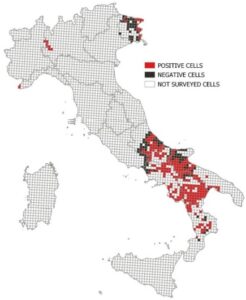
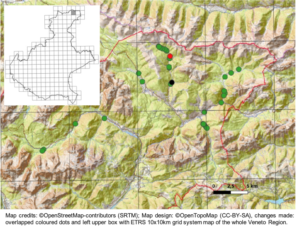
Legend: Red dots=positive data of the present survey;
Green dots=negative data;
Black dot=putative data quoted by Stokel et al., 2022.
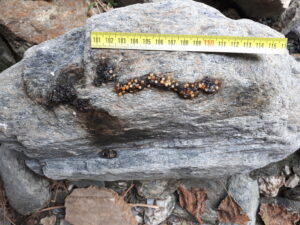
(Foto by G. De Nadai). Clearly visible on the right various undigested Salmonidae eggs. In this brook
only the common brown trout (Salmo trutta trutta) has been signalled so far (E. Marconato, ex verbis).
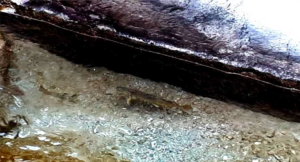
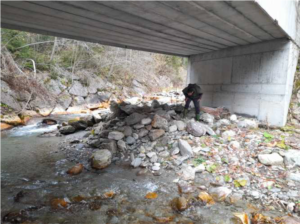
Cassol).


1 commento su “First data on the natural recovery of the Eurasian otter (<em>Lutra l. lutra</em> Linnaeus, 1758) in Veneto Region (north-eastern Italy)”
I commenti sono chiusi.